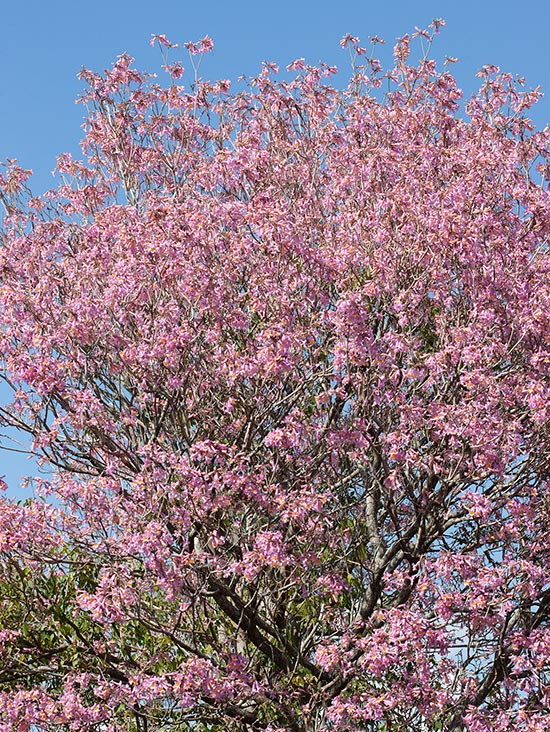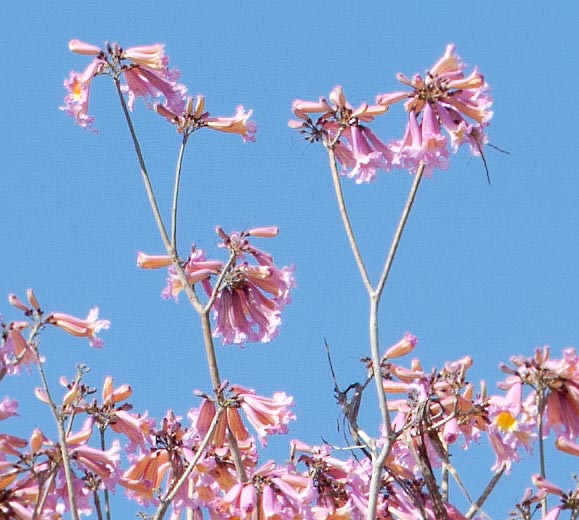Family : Bignoniaceae

Text © Pietro Puccio

English translation by Mario Beltramini

Handroanthus impetiginosus can be 30 m tall in the wild © Giuseppe Mazza
The species is native to north-eastern Argentina, Bolivia, Brazil, Colombia, Costa Rica, El Salvador, French Guyana, Guatemala, Honduras, central and southern Mexico, Nicaragua, Panama, Paraguay, Peru, Surinam and Venezuela, where it grows in the deciduous forests as well as in the pluvial ones up to about 1400 m of altitude.
The name of the genus is the combination of the name of the Brazilian botanist Oswaldo Handro (1908-1986) and of the Greek term “anthos” = flower; the name of the species comes from the Latin “impetigo, inis” = impetigo (a skin disease), in fact, they thought that the plant might treat this disease.
Common names: lavander trumpet tree, pink ipê, purple tabebuia, purple-trumpet tree, red lapacho (English); ipê-de-minas, ipê-preto, ipê roxo, ipê-roxo-da-mata, ipê-roxo-de-bola, ipê-roxo-do-grande, pau-cachorro, pau-d’arco-roxo, peúva, peúva-roxa, piuna, piuna-roxa (Portuguese-Brazil); amapa, amapa colorada, amapa morada, lapacho crespo, lapacho negro, lapacho rosado, to’obo (Spanish).
The Handroanthus impetiginosus (Mart. ex DC.) Mattos (1970) is a deciduous 8-12 m tall tree, even if, in the wild, some specimens may reach the 30 m, and diameter of the trunk up to 80 cm, with semi-globose crown and grey-brown bark, smooth in the young plants, then wrinkled and longitudinally fissured in the course of time.
The leaves, grouped at the extremity of the branches on a 5-8 cm long petiole, are opposite, palmate-compound, usually with 5-7 leaflets from elliptic to obovate with pointed apex and edge at times slightly serrate towards the apex in the adult plants, wholly serrate in the young ones, of 3-15 cm of length and 2-9 cm of breadth, coriaceous and pubescent, especially below, of dark green colour.
The inflorescences, which appear before the emission of the leaves, are corymbiform terminal panicles, thick, 9-12 cm long, carrying up to 80 flowers with campanulate tomentose calyx, 0,5-0,8 cm long, and funnelform corolla, 4-8 cm long and 3-4 cm broad, having 5 lobes with wavy edges, of lavender pink to pale purple colour with yellow throat turning dark pink with the time; rare specimens with white flowers do exist.
The fruit is a coriaceous, glabrous, dehiscent (spontaneously opening when ripe), capsule, cylindrical, 25-40 cm long and 1,5-2 cm broad, containing several flat winged seeds, 2,5-5 cm long and 1-1,5 cm (wings included) broad, which are dispersed by the wind.

The terminal inflorescences precede the deciduous leaves © Giuseppe Mazza
Usually, it reproduces by seed, which has an about three month’s long germination capability, in sandy, organic loam kept humid at the temperature of 22-24 °C, with germination times of 2-3 weeks and initial fast growth, as it can exceed the 3 m in two years under the best cultivation conditions, then slow, with the first flowering starting from the third-fifth year of age.
Species of great ornamental value when in bloom, much utilized in parks and gardens and as road tree in the tropical and subtropical climate zones, its cultivation may be tried marginally in the warm temperate climate zones, where adult plants may stand, for a short period, temperatures up to about -4 °C.
In order to grow up better, it requires an exposition in full sun and is not particular about the soil provided the same is draining; well rooted plants can resist to dry periods, in particular by the end of winter, which favour a more abundant flowering.
The wood, of yellowish colour, hard, heavy (about 960 kg/m3) and rich in tannins, is utilized in the civil and naval, for internal and external works, constructions, being very resistant to the atmospheric agents and to the xylophagous parasites, of valuable furniture and tools. The inner bark is utilized in the traditional medicine for various pathologies, even if it presents many contraindications and may reveal toxic even at low doses.
Synonyms: Tecoma impetiginosa Mart. (1843); Tabebuia avellanedae Lorentz ex Griseb. (1879); Tabebuia palmeri Rose (1891); Tecoma adenophylla Bureau & K.Schum. (1897); Gelseminum avellanedae (Lorentz ex Griseb.) Kuntze (1898); Tecoma avellanedae (Lorentz ex Griseb.) Speg. (1910); Tabebuia nicaraguensis S.F.Blake (1917); Tecoma integra (Sprague) Hassl. (1917); Tabebuia dugandii Standl. (1933); Tabebuia impetiginosa (Mart. ex DC.) Standl. (1936); Handroanthus avellanedae (Lorentz ex Griseb.) Mattos (1970); Tabebuia schunkevigoi D.R.Simpson (1972).
